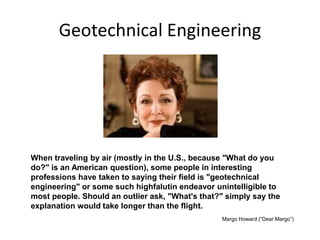Facts About Geotheta Revealed
Facts About Geotheta Revealed
Blog Article
Excitement About Geotheta
Table of ContentsRumored Buzz on GeothetaThe Best Guide To GeothetaWhat Does Geotheta Do?Geotheta Things To Know Before You BuyHow Geotheta can Save You Time, Stress, and Money.

They perform website investigations, accumulate samples, perform research laboratory tests, and examine information to examine the suitability of the ground for building projects - Engineer of Record. Based upon their findings, geotechnical designers supply recommendations for foundation style, incline security, keeping structures, and mitigation of geotechnical dangers. They work together with various other specialists, such as engineers, structural designers, and construction groups, to ensure that geotechnical considerations are incorporated into the general task design and application
By examining the actions and homes of dirt and rock, they can determine potential geotechnical risks such as landslides, soil settlement, or slope instability. Their competence assists avoid failings or crashes that could threaten lives and residential property. Here are some comprehensive responsibilities and obligations of a geotechnical engineer: Site Examination: Geotechnical designers conduct site examinations to collect information on subsurface conditions.
They translate the information to understand the residential properties and actions of the dirt and rock, including their stamina, leaks in the structure, compaction attributes, and groundwater problems. Geotechnical Analysis and Style: Geotechnical engineers analyze the data accumulated during site investigations to analyze the security and suitability of the site for building jobs. They execute geotechnical computations and modeling to examine variables such as birthing ability, negotiation, slope stability, lateral planet stress, and groundwater circulation.
The Buzz on Geotheta
Foundation Design: Geotechnical engineers play a crucial function in designing foundations that can safely support the intended framework. They assess the soil problems and lots needs to determine the proper structure kind, such as shallow structures (e.g., footings), deep structures (e.g (https://www.goodreads.com/user/show/180594840-ian-hammond)., piles), or specialized techniques like dirt enhancement. They take into consideration aspects such as negotiation limitations, bearing ability, and soil-structure interaction to create optimum foundation layouts
They assess construction plans, display website tasks, and conduct field assessments to verify that the layout suggestions are followed. If unforeseen geotechnical problems arise, they assess the scenario and offer recommendations for remediation or changes to the layout. Risk Analysis and Reduction: Geotechnical designers examine geotechnical risks and risks linked with the task website, such as landslides, liquefaction, or dirt disintegration.

Partnership and Communication: Geotechnical engineers work carefully with various other specialists associated with a job, such as designers, architectural engineers, and building teams. Efficient communication and partnership are vital to integrate geotechnical factors to consider into the total project layout and construction procedure. Geotechnical designers supply technological know-how, solution questions, and ensure that geotechnical demands are satisfied.
Little Known Questions About Geotheta.
Here are some sorts of geotechnical engineers: Structure Designer: Structure designers specialize in designing and evaluating foundations for frameworks. They analyze the soil conditions, tons requirements, and website features to determine one of the most appropriate foundation kind and layout, such as superficial foundations, deep structures, or specialized techniques like pile foundations.
They review the variables influencing incline stability, such as dirt properties, groundwater problems, and incline geometry, and develop approaches to stop incline failures and mitigate threats. Quake Engineer: Earthquake designers specialize in analyzing and creating structures to withstand seismic pressures. They examine the seismic danger of a website, evaluate dirt liquefaction capacity, and establish seismic layout criteria to guarantee the security and resilience of structures throughout earthquakes.
They do field testing, accumulate examples, and assess the accumulated data to identify the soil buildings, geologic developments, and groundwater conditions at a website. Geotechnical Instrumentation Engineer: Geotechnical instrumentation designers concentrate on tracking and measuring the actions of dirt, rock, and structures. They set up and maintain instrumentation systems that keep an eye on factors such as soil negotiation, groundwater levels, slope activities, and structural displacements to evaluate performance and supply very early cautions of possible concerns.
The Basic Principles Of Geotheta
They conduct examinations such as triaxial examinations, consolidation tests, straight shear tests, and leaks in the structure examinations to gather data for geotechnical evaluation and style. Geosynthetics Engineer: Geosynthetics designers specialize in the layout and application of geosynthetic materials, such as geotextiles, geogrids, and geomembranes. They use these products to improve dirt stability, reinforce slopes, provide water drainage remedies, and control disintegration.
They tend to be investigative individuals, which suggests they're intellectual, introspective, and inquisitive. They are interested, systematic, rational, logical, and sensible. Some of them are also social, indicating they're kind, charitable, participating, individual, caring, helpful, understanding, tactful, and pleasant. Does this noise like you? Take our complimentary occupation test to figure out if geotechnical engineer is one of your leading profession suits.
In the workplace atmosphere, geotechnical designers use specialized software devices to execute computations, create designs, and analyze data. They prepare records, evaluation project specs, interact with clients and group participants, and coordinate project activities. The workplace setting gives a conducive setting for study, analysis, and partnership with various other specialists included in the project.
9 Simple Techniques For Geotheta
They frequently see job websites to perform site examinations, assess geotechnical problems, and collect data for analysis. These brows through involve traveling to different locations, sometimes in remote or difficult terrains. Geotechnical designers may perform dirt tasting, conduct examinations, and screen building activities to make certain that the geotechnical aspects page of the project are being implemented correctly.
Geotechnical engineers additionally function in specialized geotechnical labs. Geotechnical laboratory designers work thoroughly in these settings, taking care of testing tools, running tools, and recording data.
Report this page